|
|
|
|
|
|
|
|

Notes on Translation
The electronic translation service on the York Region District School Board's website is hosted by Google Translate. The quality of the translation will vary in some of the languages offered by Google. Google Translate is a free service and currently offers translation in over 50 languages, although an impressive number, this does not capture all languages or dialects. The basic translation’s goal is to capture the general intention of the original English material.
The York Region District School Board does not guarantee the quality, accuracy or completeness of any translated information. Before you act on translated information, the Board encourages you to confirm any facts that are important to you and affect any decisions you may make.
The York Region District School Board is committed to parent, family and community engagement, and it is our hope that by providing this tool on our website that we are making our information more accessible to families whose first language is not English and thereby enabling better engagement in public education.
|
|
|
|
|
|
Chamber of the Red Thread - Shadows of Racism Project 2024
416
Chamber of the Red Thread - Shadows of Racism Project 2024
|
|
Page Content
CHAMBER of the RED THREAD:
Shadows of Racism - Voices Unheard
(Meditation begins at time index 2:25)
Original music composed by Jacky Chen. Performed by the UHS orchestra. Narration by Joyce Wu.
This project was made possible through
Alpha Education's initiative, "Shadows of Racism: Voices Unheard,"
and by Specialist High Skills Major (SHSM) funding. A heartfelt acknowledgment
is also extended to Tracey-Mae Chambers for her guidance and mentorship as a
consulting guest artist.
Welcome to the Chamber of the Red Thread Project, Unionville High School’s contribution to Alpha Education’s 2024 Shadows of Racism: Voices Unheard student exhibition. We extend our gratitude to our project’s mentoring guest artist, Tracey-Mae Chambers ((#HopeAndHealingCanada), for her invaluable guidance, and to the Aga Khan Museum for graciously hosting this exhibition.
The Red Thread originated from Chinese folklore, symbolizing an invisible bond that connected individuals destined to meet, transcending time, place, and circumstance. Traditionally, the concept of the Red Thread signified the unseen ties that bound us to those with whom we shared significant life lessons. Beyond its individual symbolism, the Red Thread extended to encompass connections within families, communities, and the collective whole of human beings. It represents the threads of fate that weave through our lives, intertwining our stories and influencing our paths. This concept resonated universally, reflecting the intricate tapestry of human experience within the grand narrative of existence.
Métis artist Tracey-Mae Chambers collaborated with Grade 12 Visual Arts students in designing and creating this artwork. Ms. Chambers shared her artistic process, inspiring students to synthesize her techniques into their own woven narratives. Each student pair wove within a pentagonal wooden frame, incorporating cultural artifacts and symbols into their tapestries. These twelve pentagons interconnected to form a dodecahedron chamber, inviting participants to reflect within its geometric structure.
To enrich the narrative, students created a meditative soundscape and voice recordings controlled by touch-sensitive sensors, enhancing the visual experience with auditory elements. This immersive environment encouraged contemplation on themes of identity, cultural heritage, and societal barriers.
The dodecahedron itself embodies mathematical perfection and harmony. As one of the five Platonic solids, its geometric form embodies unity and balance. Each vertex connects precisely to five others, forming a pentagram—a symbol of spiritual interconnectedness and unity. Embedded within its structure is the golden ratio, a mathematical proportion reflecting nature’s aesthetic harmony.
Participants are invited to meditate within the dodecahedron, engaging with the artwork’s message of unity, resilience, and the universal human experience.
Thank you for being a part of the Chamber of the Red Thread. Know that you are an integral part of the Red Thread and its web of connection. Through the Red Thread we are all connected in profound ways, our project is an exploration of those connections through storytelling, geometry and art.
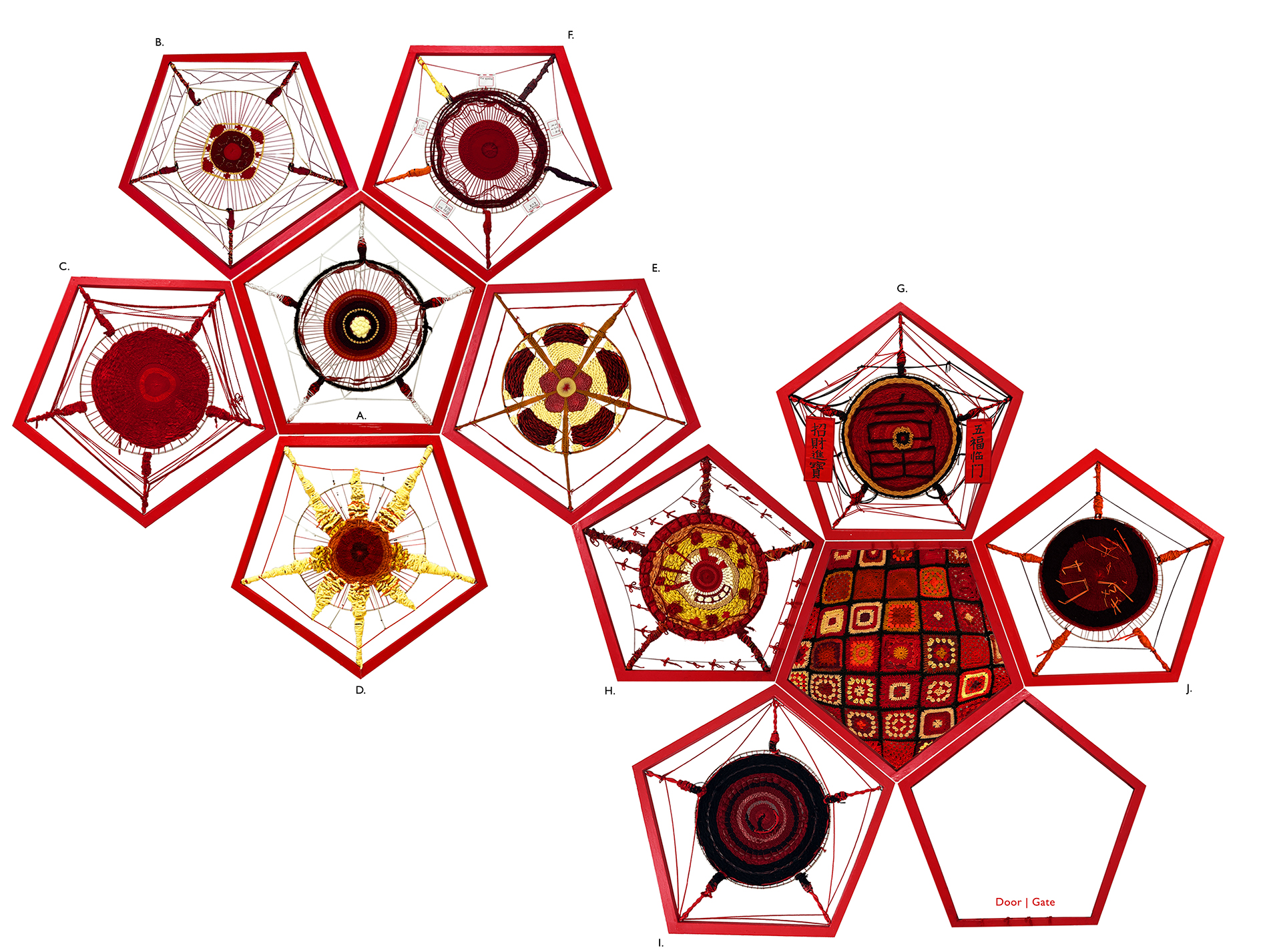
Artist Statements:
Artist: Ava Dedier
My artwork is a visual representation of the journey toward equality and peace within Black communities. Through the medium of yarn, I have woven intricate patterns in a circular formation, reminiscent of a bullseye. At the center of this woven round lies a powerful symbol—a metaphor for the ultimate spiritual destination of achieving equality, social justice, harmony, and balance.
Surrounding the center, vibrant shades of red intersect with braided circles of black, each braid meticulously crafted to resemble strands of hair. These braids hold profound significance, representing the unbreakable connection to ancestors and the enduring strength passed down through generations. They serve as a reminder of the resilience and fortitude ingrained within Black culture, anchoring individuals to their roots while propelling them forward in the ongoing struggle for social change.
The circular shape of the artwork embodies unity and solidarity, emphasizing the collective effort required to dismantle systemic injustices and build a more equitable society. Through this piece, I aim to evoke contemplation and reflection, inviting viewers to engage with the complexities of race, identity, and social justice.
A. Artists: Nicole Zhang, Jeanette Li
This piece captures two viewpoints within Canada: those of Westerners and those of the Chinese. Depending on how you analyze this piece, the meaning of certain aspects changes drastically. When viewed through a Western perspective, the red middle represents how Chinese immigrants bled for them—made to build railroads, serve the economy, and endure racism, all for a country that hated them for who they were. But when viewed from a Chinese lens, the blood red is a prominent and traditionally lucky colour in history. It represents prosperity, joy, and celebration: an homage to the Chinese reclaiming their futures for themselves, rather than yielding to Western racism and hatred.
Westerners also consider white flowers a symbol of purity, innocence, and perfection. Although they bled their Chinese settlers dry of their labour, they benefited and built what appears to be a ‘perfect’ budding society on these foundations. In Chinese culture, these ‘innocent’ white flowers represent death and mourning—meaning that in order to give rise to their prosperous red core, Chinese immigrants had to toil and sacrifice.
Overall, this piece calls attention to the complex relationship between Chinese immigrants settling in Canada and the hostile, racist attitudes, policies, and laws they were greeted with. Despite adversity, they found ways to thrive and celebrate their culture to the present day.
B. Artists: Kaitlyn Xu, Phoebe Chan
Perseverance, determination to succeed against all odds, and a strong-willed mindset passed down through generations are the backbone of the Chinese immigrant family. As individuals who have grown up in Chinese immigrant households, we have noticed the value of community and resilience within our families. For this project, we wanted to focus on these values by incorporating shapes that mimic a communal meal.
Traditionally, communal meals are designated times when families can sit together and bond over a meal, helping to build relationships. This is depicted through circular shapes, which resemble the round tables that Chinese people often eat around. This shape is significant because it represents unity and harmony, as everyone is sitting equally and sharing the same dishes in the centre. These meals are experiences that many people, as Chinese immigrants or their descendants, have had and serve as proof of the successful and comfortable lives many of us enjoy due to the resilience and hard work of our ancestors.
Driven by the need for a better life, both for personal success and for their families, our ancestors navigated a foreign land and sacrificed much for what we have today.
C. Artists: Jaxson Yao, Jett Liem
Markham is woven together by a tapestry of different backgrounds and stories—some more opaque than others, taking up significant space in an already complicated pattern. However, upon closer scrutiny, threads reveal intense saturation into a unique blend of cultures, such as the Indonesian-Chinese community. Their vibrant language and history form a small yet integral part of what Canada encompasses.
From Batik shirts, a staple pattern worn during humid Canadian summers, to their unrestrained laughter in a country as free and nurturing as Canada, there are moments where we forget the challenges that brought them here—what fate led them to this suburb of Toronto, and the importance of their presence in this Chinese-Canadian community. Despite facing adversity, including Dutch colonization in Indonesia and the Canadian railroad head tax, which forced them to adopt Dutch dining customs and abandon their ethnic names, the Indo-Chinese community perseveres.
As a descendant of such oppression, I do not shrink but feel empowered as a membrane of Canada’s future—a conduit to share my culture with others seeking the same sense of belonging.
D. Artists: Steffi Wang, Erika Chiang
Our piece touches on resilience through the viewpoints of Asians living in their home countries and Asian immigrants. We comment on the nature of places such as the Philippines, where natural disasters are common and devastating. Despite these hardships, the physical and emotional rebuilding of native communities continues to bring people together. We incorporated natural elements associated with the Filipino environment to represent various natural disasters: pearls and shells for typhoons, along with volcanic rock for eruptions and earthquakes. The beads inscribed in the ring of the sun mean "The sun always rises," symbolizing the fortitude of the Filipino people as depicted on their flag.
Relating to immigrant culture, resilience is vital during and after the transition. Asian immigrants must pick themselves up again and again to survive, a testament to their ability to settle, adapt, and prosper in a new country. Our artwork encapsulates the meaning of resilience: weaving through obstacles, rebuilding despite destruction, and proudly persevering. No matter what adversities the night brings, the sun always rises.
E. Artists: Tammy Chen, Sammi Lam
When we think of celebrating Chinese culture, we reflect on the vast traditions passed down through generations. These traditions serve as a testament to the resilience and richness of our cultural identity, keeping communities together across time. As second-generation immigrants, the significance of these traditions resonates deeply with us, reminding us of our roots and anchoring us to our Chinese heritage.
Within our families, the essence of celebration has always emphasized values such as generosity, luck, and fortune. Even in hardship, we choose to give. In our weaving, the flower symbolizes the spirit of many minorities, representing the blooming of life through the trials of winter and snow. We have used a gold and red colour palette, symbolizing good fortune and joy in Chinese culture. Additionally, Chinese red pockets are included, symbolizing happiness, energy, and luck for the New Year.
This piece serves as a reminder of the importance of preserving one’s culture and honoring the traditions passed down by our ancestors.
F. Artists: Fred Xu, Kyle Chen
In this artwork, we illustrate a personal story about Chinese immigrants who are often assigned new, Western names once they cross the border. Many immigrants with foreign names face challenges after immigrating to the West, such as mispronunciations. This often leads them to adopt a nickname for the convenience of others. Additionally, immigrants have found that more “English” names receive better responses from employers than ethnic names, giving them further reason to choose an English nickname and, in doing so, overwrite their cultural identity.
The artwork features a centered name tag placed directly in the middle of a red circle weaving. The red circle acts like a cover that forces the English name tag to be the center of attention, while also overshadowing and partially covering the surrounding name tags written in Chinese. This composition creates a message that represents the prevalence of English nicknames and the decline of ethnic names among Chinese Canadians. The red circle weaving immediately stands out, drawing attention to the English name. With the centering of Western ideals, we see the disappearance of ethnic names and the overarching presence of English names.
G. Artists: Michelle Yang, Shelby Chan
Our piece sheds light on the experiences of Chinese Canadian immigrants leaving their home country and coming to Canada in pursuit of better employment or new job opportunities. We also explore how this experience affects the lives of future generations. Chinese culture encourages the pursuit of careers seen as both profitable and reputable, such as doctor, engineer, or lawyer, though support is often lacking for careers that deviate from this norm.
Most second-generation immigrants describe having topics of their future and education come up prominently throughout their childhood, with significant pressure to succeed. While this drive to succeed can result in prestigious careers and credible achievements, it can also be a melancholy thing for second-generation immigrants to look back upon.
Our woven ring depicts a yuan coin with the Chinese character for wealth on the exterior and the character for work on the interior. Alongside the interwoven red paper with handwritten Chinese idioms for success, fraying threads are incorporated in both the pattern surrounding the frame and the interior of the weaving. This juxtaposition communicates how our careers are perceived and valued by others and ourselves.
H. Artists: Emily Ye, Sally Yu, Anna Wei
Our piece represents how Chinese culture integrates into the Toronto lifestyle. As first-generation Chinese immigrants to Canada, our relationship with our culture has been influenced and transformed by our surroundings. We use various adaptations to celebrate our cultural traditions and stay connected with our heritage.
Inspired by the intricate art of Chinese paper cutting, our woven round incorporates many detailed, recognizable symbols into a radial design. From the lanterns of Chinatown to the streetcars for transportation, to the landmarks around the city, these symbols all hold significance to our identity. The colour scheme of yellows and reds is inspired by the Chinese flag and Chinese paper cuttings. Using materials like recycled silk string to colour the form, our design connects with the historic Silk Road of our ancestors and the traditional Chinese garments.
Our piece invites the viewer to be drawn into the circular pattern, recognize the symbols, and reflect on how they relate to their own experiences. This piece also celebrates our uniquely shared and interconnected identities.
I. Artists: Emma Chen, Emma Guo
Our piece embodies the essence of Chinese Canadian immigrants’ journey and cultural evolution. At its heart lies the red and black avian figure, embodying the mythical Chinese phoenix, emblematic of our heritage. The phoenix symbolizes resilience, courage, and continuous self-betterment, virtues deeply ingrained in the ethos of Chinese Canadian immigrants. The colours transition from black to red depicts our transformative journey. Black signifies past adversities, while red symbolizes renewal and optimism, marking our ascent from past struggles to a brighter tomorrow.
The circles of red threads next to each other are the halos of light emanating from the sun, representing new hope and opportunity. The whole composition depicts a phoenix flying towards the sun, signifying that our future is full of hope and possibilities. This work is a celebration and tribute to the new life of Chinese Canadian immigrants and a testament to the evolution and transformation of our culture.
J. Artists: Gavin Chiu, Alan Zhang
Our piece represents the separation of Chinese Canadian immigrants from their families in pursuit of opportunities or prosperity. We chose this topic because, historically, Canada implemented a Chinese head tax law that prevented Chinese people from immigrating with their families. This law required Chinese immigrants to pay a head tax, starting at $50 in 1885, increasing to $100 in 1900, and then to $500 in 1903. The head tax period lasted until 1923, when it was replaced by the Chinese Immigration Act, also known as the Exclusion Act, which effectively barred Chinese immigration until 1947.
Although this law fortunately no longer exists, Chinese families are still separated today due to the pursuit of opportunities, the expense of immigrating with the entire family, or political reasons and refugee status.
Our woven ring design depicts this by utilizing two Chinese characters (which together mean family in Mandarin) being pulled apart from each other as a representation of immigration tearing families apart. We also chose red and orange as the prevalent colours because of their significance in Chinese culture. Red and orange are commonly associated with fortune and success as part of Chinese identity.
Although the head tax and exclusion policies negatively impacted Chinese families, Chinese Canadians continue to celebrate their heritage while contributing to Canada’s prosperity through excellence in creative and innovative enterprises.
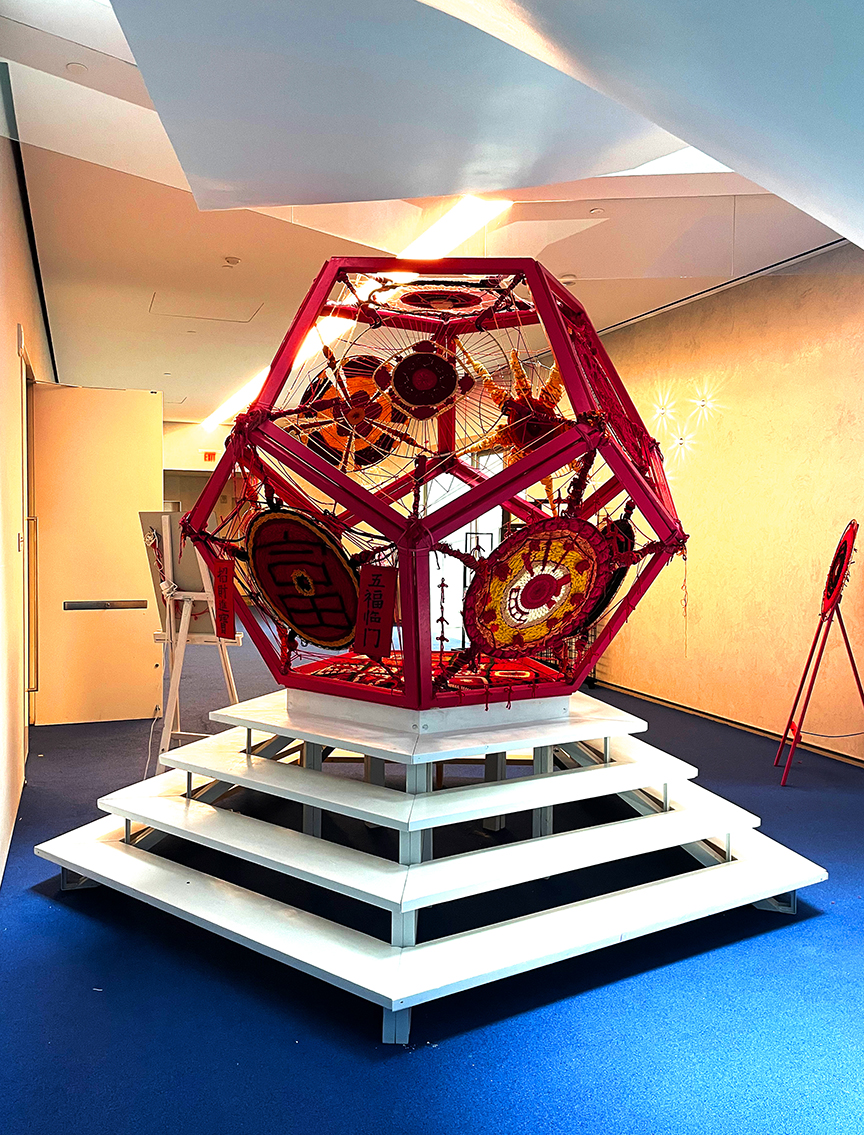 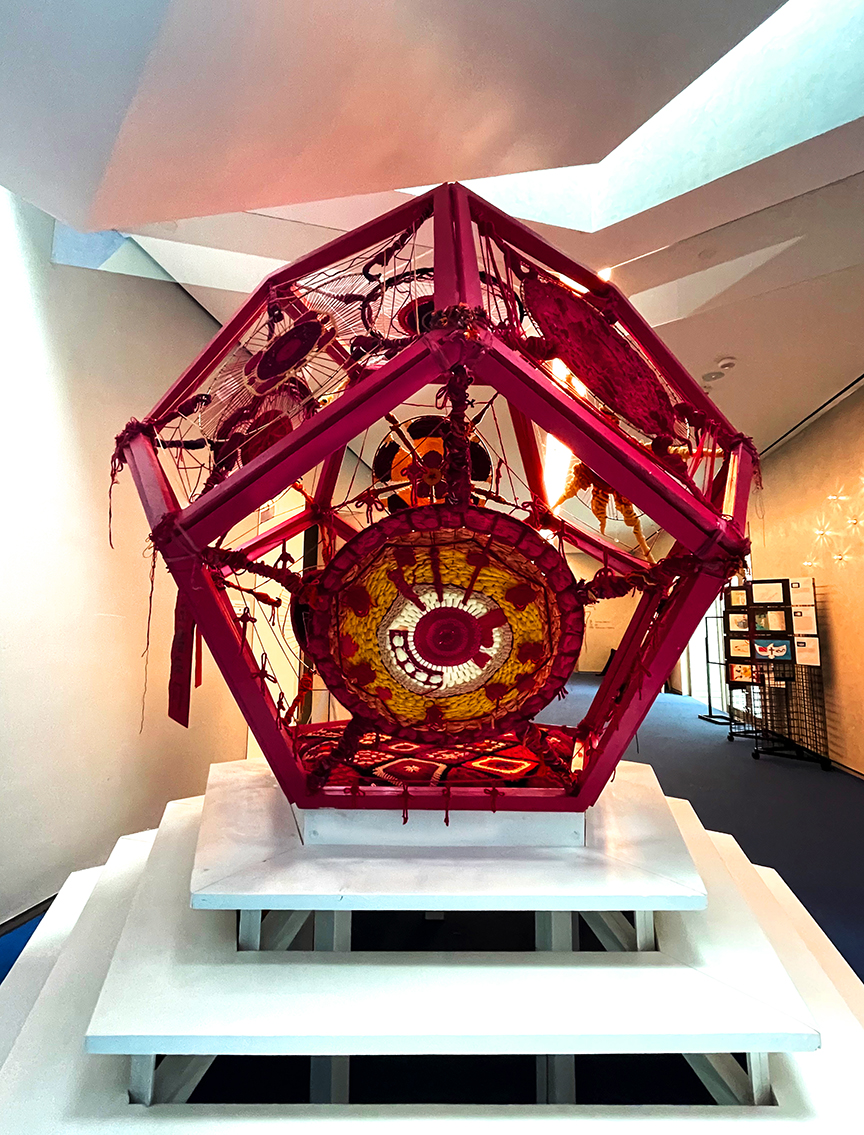
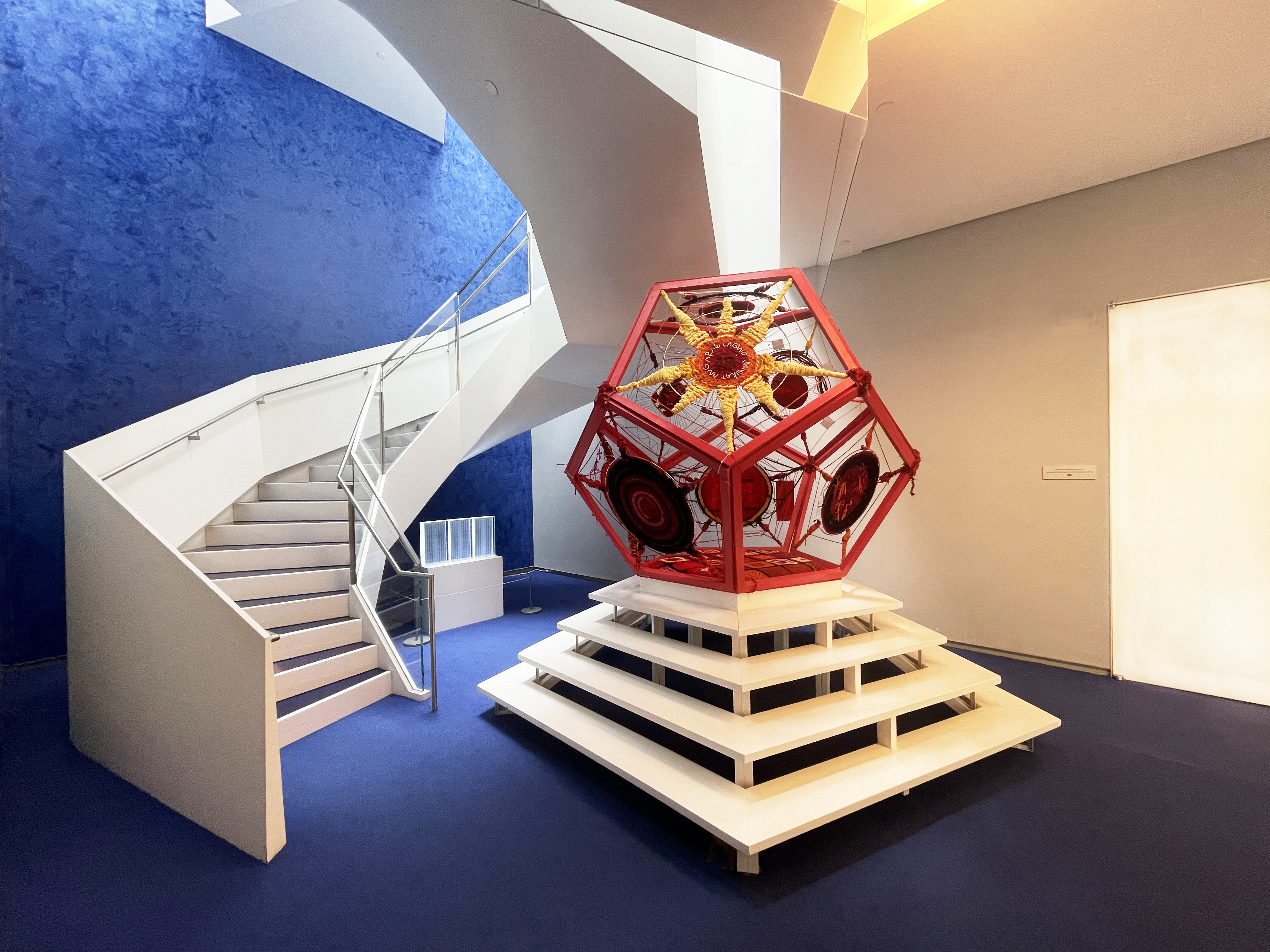
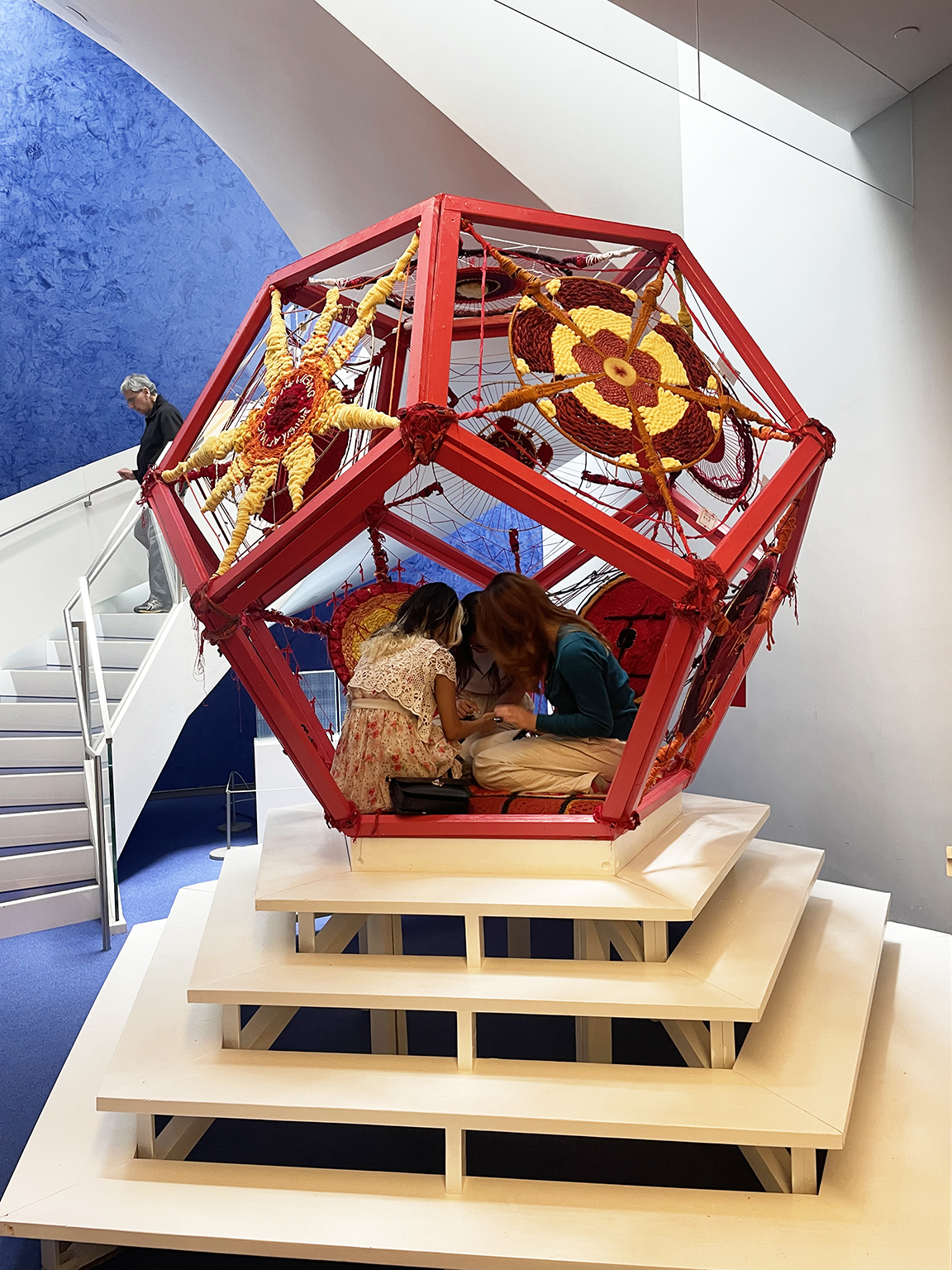
Chamber of the Red Thread installed at the Aga Khan Museum
Reiki
Reiki is a Japanese healing technique that involves the transfer of universal life energy through the hands of a practitioner to promote physical, emotional, and spiritual healing. Developed by Mikao Usui in the early 20th century, Reiki is based on the belief that an unseen "life force energy" flows through us and is what causes us to be alive. When this energy is low, we are more likely to feel stress or get sick, and when it is high, we are more capable of being happy and healthy. Reiki sessions typically involve the practitioner placing their hands lightly on or just above the recipient's body to channel energy to where it is needed. Several SHSM students from our class had the opportunity to learn and receive their level one Reiki Certification. These ideas were interegrated into the project.
The dodecahedron chamber has been infused with the creative energies by its creators through the act of weaving both, metaphorically and figuratively, personal visual narratives celebrating resilience and excellence within their communities. Additionally, Reiki Masters have infused the chamber’s ten rose quartz and ten amethyst crystal array with Reiki energy for this purpose. Thank you to GTA Reiki for supporting this compoent of the project.
10 Rose and 10 Amethyst crystals wraped an embeded at the 20 nodal vertices within the chamber.
|
|
|
|
|
|
|
|
|
|
|
|
|
|
|